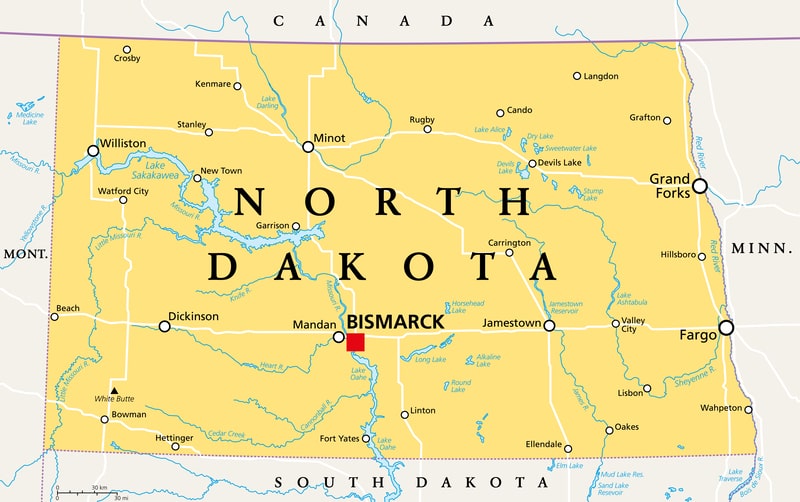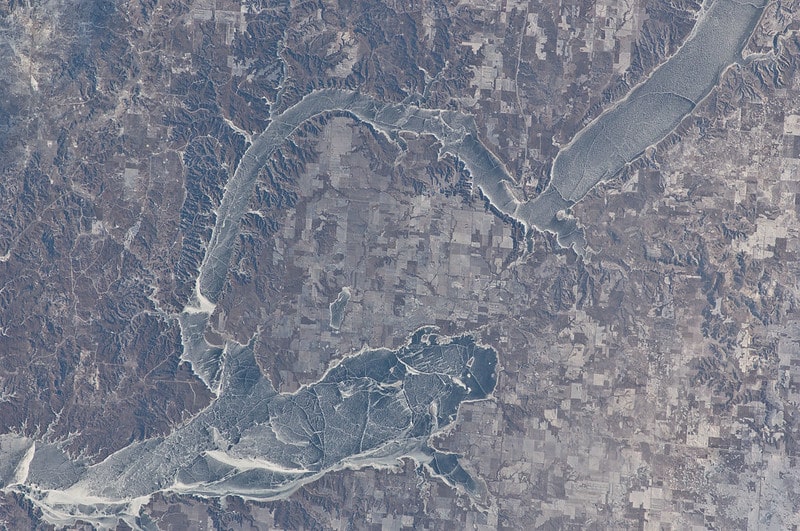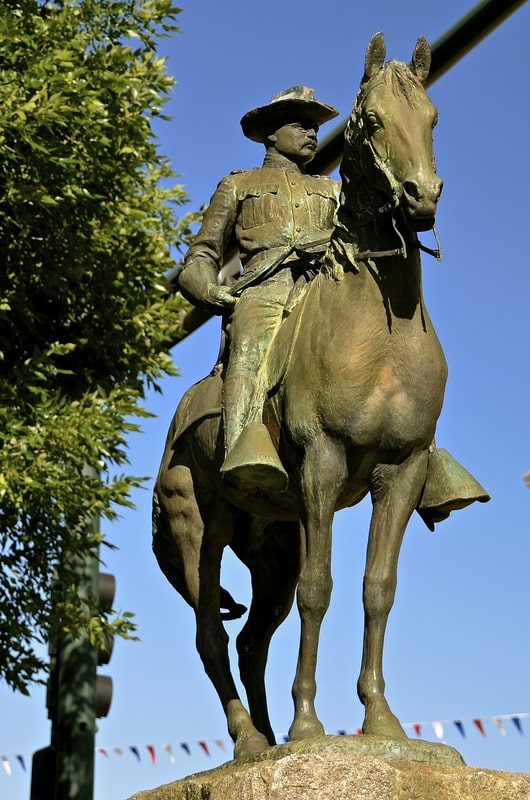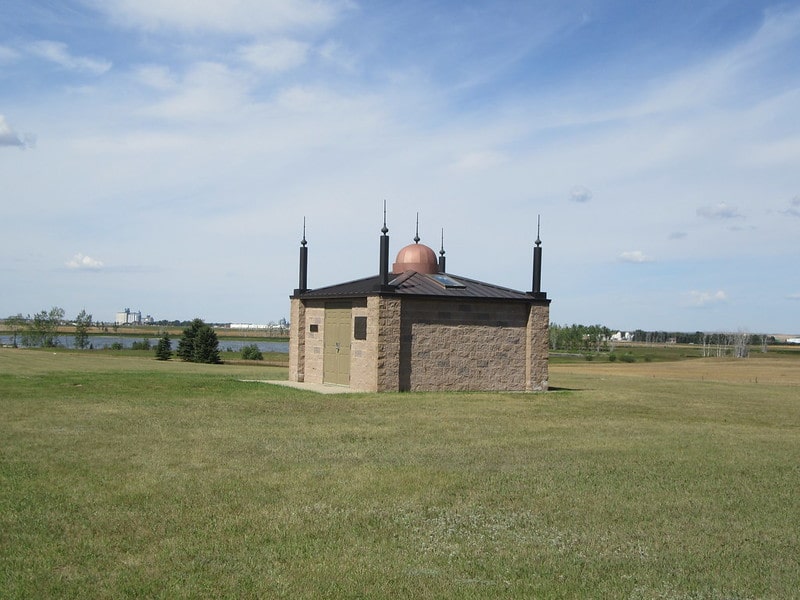Last updated on June 23rd, 2024
North Dakota is the 47th most populous and the 19th most extensive of the 50 states of the United States. It is in the midwestern and northern regions of the United States. It is right below the Canadian provinces of Manitoba and Saskatchewan. To the west is Montana, with the border marked by a stone and cottonwood every mile. To the east is Minnesota, split by the waters of the majestic Red River. The state attained statehood on November 2, 1889, becoming the 39th State to join the union.
Its three bordering states are Minnesota, Montana, and South Dakota. North Dakota (nicknamed: Flickertail State, Peace Garden State, Rough Rider State, Sioux State) has 53 counties. The state’s capital is Bismarck. The postal abbreviation for North Dakota is ND. With these facts about North Dakota, let us learn more about its history, geography, people, culture, economy and much more.
Interesting facts about North Dakota
1. The land is home to several Native American tribes, although France, Spain, and England took control of the area in the 1700s. The US purchased it in 1803 and called it the Dakota Territory, with “Dakota” meaning “friend” in the Sioux Indian language.
2. A settler boom occurred from 1879 to 1886 in North Dakota. That was when more than 100,000 farmers and other settlers moved into the area.
3. An interesting historical fact is that most immigrants between 1870 and 1930 were from Norway. That is why one out of every three North Dakotans is of Norwegian heritage.
North Dakota on the map
4. The Dakota Territory used to be one big mass but people from the North and South began to clash over differences in lifestyle, political beliefs, and conflicts with the natives. In 1887, voters approved splitting the territory in two.
5. North Dakota may be the 39th state or not to have joined the union. Both North and South Dakota were admitted at the same time. President Benjamin Harrison asked the then Secretary of State, James Blaine, to shuffle up the paperwork to avoid anyone ever knowing the state that was signed first. Still, North Dakota is listed as the 39th state with South Dakota occupying the 40th spot. And all this is because of alphabetical order.
6. A few attempts were launched to drop “North” from the state’s name and go by the simpler “Dakota”. The first one was in 1947 and the second was in 1989. However, both were unsuccessful due to the pushback from the Legislative Assembly.
7. Interesting to note is that North Dakota may not have been a state until 2012. That’s because the state’s constitution doesn’t require any official to take an oath, resulting in disobeying federal law.
8. In 1956, the state’s Motor Vehicle Department placed this nickname (Peace Garden State) on all license plates – inspired by the International Peace Garden at the border with Manitoba, Canada. The nickname was so popular that the state legislature formally adopted it in 1957.
9. Only one percent of North Dakota is woodland or forest. Most of the state’s forests are in the badlands or near lakes and streams.
10. True to its name, the Badlands is a harsh stone valley shaped by erosion for millions of years. It contains the fossils of ancient sea creatures like fish and clam. Within this area is the state’s highest point at 3,506 feet called White Butte.
11. The eastern portion of North Dakota is a flat valley. With its mineral-rich soil, it is among the world’s most fertile areas. That’s why it is filled with productive farms that feed the US. It is interesting to note that the valley was once the floor of an ancient lake.
 12. The western side is dubbed as the Drift Prairie region. “Drift” is a type of soil made up of sand, clay, and gravel. The area is dotted with hills, lakes, valleys, and wetlands. It’s perfect for ranchers because of the abundance of prairie grass and wheat.
12. The western side is dubbed as the Drift Prairie region. “Drift” is a type of soil made up of sand, clay, and gravel. The area is dotted with hills, lakes, valleys, and wetlands. It’s perfect for ranchers because of the abundance of prairie grass and wheat.
13. North Dakota is part of the Great Plains region, which has been dubbed as the “Saudi Arabia of wind energy”. The flat terrain enables sustained winds of 10 mph or more, making it cost-effective to build the necessary infrastructure.
14. The southwestern region of North Dakota is also known as the Banana Belt. That is because of warmer winters in that area compared to the rest of the state.
15. Interestingly, there is a Red River Valley in North Dakota and Texas. It separates the state from Minnesota and is not the one the song is about.
16. There are claims from some quarters that North Dakota, nicknamed the city of Rugby, is the geographical center of North America, although this is largely unverified.
17. Did you know North Dakota is the state in the US that never had an earthquake? Minor earthquakes of low magnitude do occur there once every decade.

18. Lake Sakakawea formed by Garrison Dam on the Missouri River is named after a Shoshone woman named Sacagawea. In 1805 – 1806, she worked as a guide and interpreter during the Lewis and Clark expedition that helped put the area on the map. The lake was created in 1954. It is one of the largest artificial reservoirs in the United States.
19. The only National Park named after a U.S. president is the Theodore Roosevelt National Park. Actually, the National Park is dedicated on a piece of land once owned by the former president. The park covers over 70,000 acres of land with nearly half being wilderness areas. Visitors can see feral horses, bison, elk, deer, bald eagle, hawk, falcon, and other animals roaming freely.

20. Theodore Roosevelt‘s life was changed a great deal by North Dakota. The future president visited Badlands to hunt buffalos when he was 24 years old back in 1883. But barely two weeks in North Dakota, Roosevelt acquired two cattle ranches. When he lost his mother and wife a couple of months later, he escaped to North Dakota. While here, he transformed into a cowboy game hunter that many people later knew him for.
21. President Roosevelt once said about the state “I would never have been President if it had not been for my experiences in North Dakota.”
22. Fargo, the largest city in the state takes its name from William Fargo, the co-founder of Wells Fargo & Company.
23. The state has more cattle than people. It has a population of roughly 1.8 million cattle, compared to just about 750,000. The cattle are more than twice the human population.
24. Did you know that Ruso, a hamlet in McLean County, is the least populous incorporated place in North Dakota? The city has a population of four.
25. North Dakota has a large population of ground squirrels called flickertails. The name comes from the way that the animal flicks its tail while running or entering a burrow. In 1953, a senate bill was filled to adopt the Flickertail as the state’s official symbol.
26. Huge bison herds once roamed North Dakota plains. However, by 1900, there were only less than 600 of these animals remaining. Thanks to the initiatives spearheaded by President Roosevelt, today there are more than 90,000 bison in the state. To see true buffalos, one has to visit Europe and Asia. Early European settlers mistook them for buffalos but the truth is that they aren’t buffalos.
27. Kenmare in North Dakota is the place to go for those who love hunting geese. It is a hunting haven with an annual count of more than 400,000 snow geese.
28. Thousands of cowboys are streaming to North Dakota annually for the many rodeos. The state hosts nearly 50 regional and local rodeos.
29. Although the wild prairie rose is the state’s state flower, the sunflower is the one flower grown here more than anything else. This is grown mainly for its oil. North Dakota is often the best when it comes to sunflower production. However, in 2011 and 2013, it came behind South Dakota due to flooding and wet weather.
30. English may be the official language of North Dakota, but they only made it official in 1987. A small percentage of residents still have German as their first language.
31. The American Elm was chosen to be the North Dakota State Tree in 1947. It is a hardy tree found all over the state and grows 120 feet high.
32. A fun fact is that the chokecherry is declared the state fruit of North Dakota. It is named like that because of the sharp, bitter taste of the fruit.
33. North Dakota didn’t choose a state animal. The closest they have is the Nokota Horse, which was designated in 1993.

34. Did you know that the inventor of the camera came from North Dakota? David Henderson invented the camera in 1887. To give it a name, he shuffled the first four letters of the word “Dakota” and then added the letter “K” to make the word “Kodak”. He was later to sell Kodak camera rights to George Eastman. In return, Houston received a total of $5750 for his efforts. Eastman said, “A trademark should be short … vigorous … incapable of being misspelled …” and “it must mean absolutely nothing.”
35. J. Ross Moore, an inventor from North Dakota, designed the first drum-type clothes dryer in 1938. It was also the first electrically operated dryer.
36. The oldest attraction in Ellendale, Dickey County, North Dakota, is the Opera House. It was constructed in 1909 and houses about a thousand patrons.

37. It is believed that the first mosque in the entire United States was built in North Dakota, just outside the small town of Ross. However, there is no way to verify this claim.
38. You will find a giant pyramid in the middle of nowhere in Nekoma, North Dakota. It was constructed to be part of a missile silo complex.
39. A solar calendar that predicts astronomical events, known as Mystical Horizons, is in Bottineau, North Dakota. It also has a giant sundial on the site.
40. On a Sunday morning, December 28, 1930, the State Capitol Building in Bismarck was wholly destroyed. It burned to the ground without anybody being able to do anything about it. It cost more to extend the North Dakota State Capitol Building in 1980 than to complete it in 1935. Building it cost $2 million, and extending it cost five times as much.
41. Did you know North Dakota is one of only four states with a tower-style State Building? The one in this state is 19 stories high. The North Dakota State Building has an observation deck on the top floor. It provides a scenic view of the Missouri River Valley.
42. Another famous North Dakota Landmark is the Custer House. It was restored to look like it looked when General Custer lived in it and is open for tours.
43. The Dinosaur Museum of the state of North Dakota is in Dickenson. Twelve full-scale dinosaurs found their home there, including a complete Triceratops.
44. Jamestown also plays host to the National Buffalo Museum, which contains its bison herd. Of these, the most famous has to be the 3 rare albinos. These are Dakota Miracle, Dakota Legend, and White Cloud. According to a Native American Legend, albino buffaloes are sacred. It’s not clear if these have some super-buffalo powers, but there is no doubt about their breath taking cuteness.
45. If you ever find yourself in the town of Dunseith, don’t forget to look for the giant Wee’l Turtle. The sculpture is made from over 2,000 car wheels sporting different shades of green. It’s a massive work of art that never fails to amaze visitors.
46. The original grave of the Hunkpapa Sioux leader is near Fort Yates, North Dakota. Find it at the Sitting Bull Burial State Historic Site.
47. Travelers can stay in an enchanted castle in Regent, North Dakota. It used to be a school but was transformed into a 23-room castle.
48. A small village named Wanamaker was moved building by building in 1905. That was done to be closer to the railroad and is now known as Turtle Lake.
49. The Historic site, Big Hidatsa Village, was occupied from 1740 until around 1850. It is considered the largest of three Hadasta villages near the Knife River.
50. The Painted Canyon between Belfield and Medora in North Dakota is a famous tourist destination. It is named after the many prehistoric paintings found on the limestone walls.
51. Located in downtown Fargo, North Dakota, is the Red River Market. It’s a farmers market with a lively atmosphere and is an excellent experience for families.
52. With 43 abandoned towns in North Dakota, it is not strange that some may think they are haunted. It may not be true, but some of these towns are suspiciously grim, like Arena.
53. Don’t visit the Riverside Cemetery in Fargo, North Dakota, if you are afraid of ghosts. Knocking noises have been recorded coming from the cemetery.
. . . continue reading on the next page
